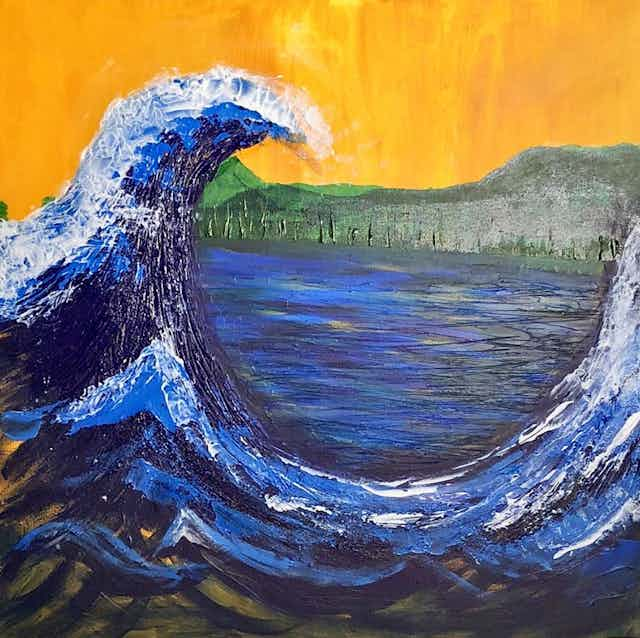Assessing the Social Impact of Trump Art on Modern Artistic Motions
Assessing the Social Impact of Trump Art on Modern Artistic Motions
Blog Article
Looking Into the Diverse World of Artistic Expression: From Surrealism to Abstract Realistic Look
In the realm of imaginative expression, from the dreamlike landscapes of surrealism to the intricate play of light and type in abstract realism, musicians have actually continuously pushed the limits of creativity and creativity. As we check out the complex world of art, we are presented with a tapestry of designs, techniques, and approaches that test our understanding and provoke consideration.
Surrealism: Releasing the Subconscious
Surrealism, a progressive imaginative movement of the 20th century, looked into the depths of the subconscious, introducing a world of dream-like images and non-traditional associations. Spearheaded by artists like Salvador Dali, René Magritte, and Joan Miró, Surrealism looked for to test the traditional ways of recognizing and seeing art. Through techniques such as automatism and dream analysis, Surrealist artists intended to tap right into the unconscious mind to expose concealed realities and desires.
Among the crucial elements of Surrealism was the emphasis on the illogical and the incredible. By integrating unforeseen aspects in their works, Surrealist artists intended to develop a feeling of disorientation and shock in the viewer. This interruption of reasoning and reason was meant to provoke a much deeper expedition of the subconscious and the secrets of the human psyche.
Abstract Realism: Redefining Understanding
Testing typical creative limits, Abstract Realism redefines assumption via the combination of recognizable elements with abstract kinds. This cutting-edge strategy to art integrates the representational accuracy of realism with the imaginative flexibility of abstraction, offering visitors an one-of-a-kind aesthetic experience that motivates them to examine their perception of fact.
In Abstract Realistic look, artists make every effort to catch the essence of their topics while likewise instilling their deal with a feeling of deepness and intricacy with abstract elements. By mixing the accustomed to the strange, these musicians welcome target markets to engage with their pieces on multiple degrees, encouraging them to discover the nuances of color, kind, and texture.

Cubism: Breaking Up Fact
Using geometric types and fragmented point of views, Cubism changed the artistic representation of truth in the very early 20th century. This technique not just deconstructed fact but likewise highlighted the monotony of the canvas, leading the means for future abstract art activities.

Cubism can be categorized into two main stages: Analytical Cubism, identified by monochromatic color schemes and elaborate, fragmented forms; and Synthetic Cubism, which incorporated collage elements and brighter colors into the structures. With these unique phases, Cubism influenced not only painting but also style, style, and sculpture. trump art. Its effect resounded across the art world, motivating artists to explore new means of interpreting and representing the globe around them
Expressionism: Feelings on Canvas
Checking out the midsts of human feelings via meaningful and brilliant brushstrokes, Expressionism emerged as a profound artistic motion in the early 20th century. Unlike previous art activities that concentrated on portraying the exterior globe, Expressionism explored the internal world of the artist's subconscious, aiming to evoke raw feelings and provoke natural responses from customers.
Expressionist artists, such as Edvard Munch, Egon Schiele, and Emil Nolde, declined typical concepts of charm and realistic look for misshaping kind and color to convey subjective feelings. Using overstated brushwork, bold colors, and distorted numbers assisted create a feeling of unease, alienation, or interest in their jobs.
Among the most famous examples of Expressionism is Munch's "The Scream," which records the extreme anxiety and anguish of modern life with its swirling, distorted number against a blood-red sky. Via their emotionally charged learn this here now jobs, Expressionist artists looked for to challenge traditional imaginative norms and supply a home window into the rough midsts of the human heart.
Contemporary Art: Developing Perspectives

One of the defining features of contemporary art is its consistent evolution and ability to adapt to altering social landscapes. Musicians are progressively integrating modern technology right into their practice, blurring the lines in between the physical and digital realms. This combination of tools enables cutting-edge ways of storytelling and engaging with audiences in a much more interactive manner.
Furthermore, contemporary art commonly works as a system for social discourse, addressing pressing issues such as identification, national politics, and the setting. Musicians are utilizing their job to prompt and trigger crucial discussions idea, dropping light on the complexities of the globe we reside in. As viewpoints remain to progress, contemporary art stays a dynamic and influential pressure in shaping our social landscape.
Conclusion
To conclude, the globe of imaginative expression includes a large range of styles and activities, each with its own distinct strategy to sharing significance and emotion. From surrealism's expedition of the subconscious to abstract realistic look's redefining of understanding, and Home Page from cubism's fragmentation of reality to expressionism's representation of feelings, art remains to evolve and test point of views - trump art. Contemporary art shows the ever-changing globe we stay in, using brand-new methods to translate and recognize the complexities of our reality
As we explore the complex globe of art, we are offered with a tapestry of styles, techniques, and approaches that challenge our understanding and provoke contemplation. Its impact reverberated across the art globe, motivating musicians to discover new means of representing the world and analyzing around them.

Report this page